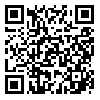1. White RMB, Pasco MC, Korous KM, Causadias JM. A systematic review and meta‐analysis of the association of neighborhood ethnic‐racial concentrations and adolescent behaviour problems in the U.S. J Adolesc. 2020;78(1):73–84. [
DOI]
2. Barone L, Carone N, Costantino A, Genschow J, Merelli S, Milone A, et al. Effect of a parenting intervention on decreasing adolescents’ behavioral problems via reduction in attachment insecurity: a longitudinal, multicenter, randomized controlled trial. J Adolesc. 2021;91(1):82–96. [
DOI]
3. Kobak R, Abbott C, Zisk A, Bounoua N. Adapting to the changing needs of adolescents: parenting practices and challenges to sensitive attunement. Curr Opin Psychol. 2017;15:137–42. [
DOI]
4. Ghosh A, Shum C. Why do employees break rules? understanding organizational rule-breaking behaviors in hospitality. Int J Hosp Manag. 2019;81:1–10. [
DOI]
5. Pirahari N. Investigating the relationship between cultural and social factors with unlawfulness in Semnan. Journal of Social Order. 2020;12(1):141–62. [Persian] [
Article]
6. Mirfardi A, Ahmadi Gharnaie H. Investigating the level of social trust in interpersonal relationships and its relationship with the lawlessness rate in Yasuj. Journal of Social Order. 2017;8(4):59–84. [Persian] [
Article]
7. Haavind H. Masculinity by rule-breaking: cultural contestations in the transitional move from being a child to being a young male. NORA-Nordic Journal of Feminist and Gender Research. 2003;11(2):89–100. [
DOI]
8. Trinh NH, Jahan AB, Chen JA. Moving from cultural competence to cultural humility in psychiatric education. Psychiatr Clin North Am. 2021;44(2):149–57. [
DOI]
9. Espinosa AE, Arrieta JA, Rojas GR. Cultural damage and reparation of victims in the Colombian armed conflict. The case of the black peasant community of San Cristóbal (Montes de María – Colombia). Social Identities. 2021;27(4):498–515. [
DOI]
10. Brown KL. The ‘hidden injuries’ of school desegregation: cultural trauma and transforming African American identities. Am J Cult Sociol. 2016;4(2):196–220. [
DOI]
11. Rothenberg WA, Lansford JE, Bacchini D, Bornstein MH, Chang L, Deater‐Deckard K, et al. Cross‐cultural effects of parent warmth and control on aggression and rule‐breaking from ages 8 to 13. Aggr Behav. 2020;46(4):327–40. [
DOI]
12. Navabakhsh M, Karimi F. Evasion and social and cultural factors affecting it: a study of young people aged 18–29 in Marivan. Intercultural Studies Quarterly. 2018;13(36):97–121. [Persian] [
Article]
13. Mirfardi A, Mokhtari M, Faraji F, Daneshpazir H. A study of the impact of citizenship culture on tendency toward law-breaking (the case of Yasouj city). Strategic Research on Social Problems in Iran University of Isfahan. 2015;4(2):1–20. [Persian] [
Article]
14. Nieuważny J, Nowakowski K, Ptaszyński M, Masui F, Rzepka R, Araki K. Does change in ethical education influence core moral values? towards history- and culture-aware morality model with application in automatic moral reasoning. Cognitive Systems Research. 2021;66:89–99. [
DOI]
15. Monteiro F, Leite C, Rocha C. Ethical education as a pillar of the future role of higher education: analysing its presence in the curricula of engineering courses. Futures. 2019;111:168–80. [
DOI]
16. Ashby-King D, Boyd K. Integrative ethical education: an exploratory investigation into a relationally based approach to ethics education. Journal of Communication Pedagogy. 2020;3:65–81. [
DOI]
17. Shekari A, Rahimi H, Ghoraba M. The pathology of ethical education base on hidden curriculum (the case of university of Kashan). Journal of Higher Education Curriculum Studies. 2014;5(9):124–43. [Persian]
18. Zamani A, Taghipour F. Shenasaei asib haye akhlaghi va khanevadegi estefade az shabake haye ejtemaei majazi dar miyan farzandane pesare shahr Isfahan [Identifying the moral and family harms of using virtual social networks among male children in Isfahan city]. Akhlagh Religious Extension Quarterly. 2018;13(50):85–109. [Persian] [
DOI]
19. Ali Asgari E, Niazi Gh. Naghshe akhlagh dar pishgiri az ghanoon gorizi [The role of ethics in preventing lawlessness]. Akhlagh-e-Zisti. 2016;3(9):123–43. [Persian]
20. Vardaman JM, Gondo MB, Allen DG. Ethical climate and pro-social rule breaking in the workplace. Human Resource Management Review. 2014;24(1):108–18. [
DOI]
21. Karimi R, Rostami H. Processing the causes of tendencies and the ways to prevent crimes and educational injuries in the textbooks of "social studies" and "thinking and lifestyle" among the high school students. Journal of Social Order. 2020;12(2):55–76. [Persian] [
Article]
22. Green SB. How many subjects does it take to do a regression analysis. Multivariate Behav Res. 1991;26(3):499–510. [
DOI]
23. Zare Shahabadi A, Torkan R. A Survey of relationship between social capital and law evasion among Yazd city. Cultural Studies & Communication. 2012;8(27):84–118. [Persian] [
Article]





